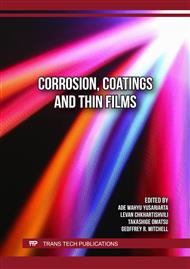[1]
Hans-Holger Rogner, F Barthel, M Cabrera, A Faaij, M Giroux, D Hall, V Kagramanian, S Kononov, T Lefevre, R Moreira, et al. Energy resources. Technical report, UNDP/UNDESA/WEC: Energy and the Challenge of Sustainability. World Energy, 2000 D. P. Dubal, O. Ayyad, V. Ruiz, and P. G´omez-Romero. Hybrid energy storage: the merging of battery and supercapacitor chemistries. Chemical Society Reviews, 44(7):1777–1790, 2015.
DOI: 10.1039/c4cs00266k
Google Scholar
[2]
Scott Evers and Linda F Nazar. New approaches for high energy density lithium–sulfur battery cathodes. Accounts of chemical research, 46(5):1135–1143, 2013.
DOI: 10.1021/ar3001348
Google Scholar
[3]
Jianyun Cao, Xiaohong Li, Yaming Wang, Frank C. Walsh, Jia-Hu Ouyang, Dechang Jia, and Yu Zhou. Materials and fabrication of electrode scaffolds for deposition of mno2 and their true performance in supercapacitors. Journal of Power Sources, 293:657–674, October 2015.
DOI: 10.1016/j.jpowsour.2015.05.115
Google Scholar
[4]
Mustafa Ergin S¸ahin, Frede Blaabjerg, and Ariya Sangwongwanich. A comprehensive review on supercapacitor applications and developments. Energies, 15(3):674, 2022.
DOI: 10.3390/en15030674
Google Scholar
[5]
Elda M Melchor-Mart´ınez, Rodrigo Macias-Garbett, Alonso Malacara-Becerra, Hafiz MN Iqbal, Juan Eduardo Sosa-Hern´andez, and Roberto Parra-Sald´ıvar. Environmental impact of emerging contaminants from battery waste: A mini review. Case Studies in Chemical and Environmental Engineering, 3:100104, 2021.
DOI: 10.1016/j.cscee.2021.100104
Google Scholar
[6]
Maria Sarno. Nanotechnology in energy storage: the supercapacitors, page 431–458. Elsevier, 2020.
Google Scholar
[7]
Thierry Brousse, Daniel B´elanger, and Jeffrey W. Long. To be or not to be pseudocapacitive?
Google Scholar
[8]
Journal of The Electrochemical Society, 162(5):A5185–A5189, 2015.
Google Scholar
[9]
Nilesh R. Chodankar, Hong Duc Pham, Ashok Kumar Nanjundan, Joseph F. S. Fernando, Kolleboyina Jayaramulu, Dmitri Golberg, Young-Kyu Han, and Deepak P. Dubal. True meaning of pseudocapacitors and their performance metrics: Asymmetric versus hybrid supercapacitors. Small, 16(37), August 2020.
DOI: 10.1002/smll.202002806
Google Scholar
[10]
Aranganathan Viswanathan and Adka Nityanada Shetty. Reduced graphene oxide/vanadium pentoxide nanocomposite as electrode material for highly rate capable and durable supercapacitors. Journal of Energy Storage, 27:101103, February 2020.
DOI: 10.1016/j.est.2019.101103
Google Scholar
[11]
Qiang Liu, Munir H. Nayfeh, and Siu-Tung Yau. Supercapacitor electrodes based on polyaniline–silicon nanoparticle composite. Journal of Power Sources, 195(12):3956–3959, June 2010.
DOI: 10.1016/j.jpowsour.2009.12.042
Google Scholar
[12]
Wei Chen, Chuan Xia, and Husam N. Alshareef. One-step electrodeposited nickel cobalt sulfide nanosheet arrays for high-performance asymmetric supercapacitors. ACS Nano, 8(9):9531–9541, August 2014.
DOI: 10.1021/nn503814y
Google Scholar
[13]
Jie Wang, Shengyang Dong, Bing Ding, Ya Wang, Xiaodong Hao, Hui Dou, Yongyao Xia, and Xiaogang Zhang. Pseudocapacitive materials for electrochemical capacitors: from rational synthesis to capacitance optimization. National Science Review, 4(1):71–90, December 2016.
DOI: 10.1093/nsr/nww072
Google Scholar
[14]
Dharshini Mohanadas, Muhammad Amirul Aizat Mohd Abdah, Nur Hawa Nabilah Azman, Jaafar Abdullah, and Yusran Sulaiman. A promising negative electrode of asymmetric supercapacitor fabricated by incorporating copper-based metal-organic framework and reduced graphene oxide.
DOI: 10.1016/j.ijhydene.2021.08.081
Google Scholar
[15]
International Journal of Hydrogen Energy, 46(71):35385–35396, October 2021. Laifa Shen, Le Yu, Hao Bin Wu, Xin-Yao Yu, Xiaogang Zhang, and Xiong Wen Lou. Formation of nickel cobalt sulfide ball-in-ball hollow spheres with enhanced electrochemical pseudocapacitive properties. Nature Communications, 6(1), March 2015.
DOI: 10.1038/ncomms7694
Google Scholar
[16]
Qi-Long Zhu and Qiang Xu. Metal–organic framework composites. Chemical Society Reviews, 43 (16): 5468–5512, 2014.
Google Scholar
[17]
Shashank Sundriyal, Harmeet Kaur, Sanjeev Kumar Bhardwaj, Sunita Mishra, Ki-Hyun Kim, and Akash Deep. Metal-organic frameworks and their composites as efficient electrodes for supercapacitor applications. Coordination Chemistry Reviews, 369:15–38, 2018.
DOI: 10.1016/j.ccr.2018.04.018
Google Scholar
[18]
Yujuan Cao, Wu Yang, Mingyue Wang, Ning Wu, Longwen Zhang, Qixia Guan, and Hao Guo. Metal-organic frameworks as highly efficient electrodes for long cycling stability supercapacitors. International Journal of Hydrogen Energy, 46(35):18179–18206, May 2021.
DOI: 10.1016/j.ijhydene.2021.03.003
Google Scholar
[19]
Rajat Saha, Kajal Gupta, and Carlos J. G´omez Garc´ıa. Strategies to improve electrical conductivity in metal–organic frameworks: A comparative study. Crystal Growth amp; Design, 24(5):2235–2265, February 2024.
DOI: 10.1021/acs.cgd.3c01162
Google Scholar
[20]
Xihong Lu, Minghao Yu, Gongming Wang, Yexiang Tong, and Yat Li. Flexible solid-state supercapacitors: design, fabrication and applications. Energy amp; Environmental Science, 7(7):2160, 2014.
DOI: 10.1039/c4ee00960f
Google Scholar
[21]
Deepak P. Dubal, Nilesh R. Chodankar, Do-Heyoung Kim, and Pedro Gomez-Romero. Towards flexible solid-state supercapacitors for smart and wearable electronics. Chemical Society Reviews, 47(6):2065–2129, 2018.
DOI: 10.1039/c7cs00505a
Google Scholar
[22]
Zhiqiang Niu, Li Zhang, Lili Liu, Bowen Zhu, Haibo Dong, and Xiaodong Chen. All-solid-state flexible ultrathin micro-supercapacitors based on graphene. Advanced Materials, 25(29):4035–4042, May 2013.
DOI: 10.1002/adma.201301332
Google Scholar
[23]
Shanlu Guo, Ruihe Zhu, Jingwei Chen, Weilin Liu, Yuxiang Zhang, Jianmin Li, and Haizeng Li. Mxene-based all-solid flexible electrochromic microsupercapacitor. Microsystems and Nanoengineering, 10(1), June 2024.
DOI: 10.1038/s41378-024-00720-6
Google Scholar
[24]
Eunji Kim, Jinkyu Song, Tae-Eun Song, Hyeri Kim, Yong-Jae Kim, Yeon-Wha Oh, Sanghee Jung, Il-Seok Kang, Yury Gogotsi, Hee Han, Chi Won Ahn, and Yonghee Lee. Scalable fabrication of mxene-based flexible micro-supercapacitor with outstanding volumetric capacitance. Chemical Engineering Journal, 450:138456, December 2022.
DOI: 10.1016/j.cej.2022.138456
Google Scholar
[25]
N.C. Maile, S.K. Shinde, D.–Y. Kim, K.C. Devarayapalli, and Dae Sung Lee. Synthesis of nickel cobalt sulfide on ni foam for improved electrochemical energy storage: Effect of binder-free reverse pulse potentiostatic electrodeposition and redox additive. Journal of Alloys and Compounds, 967:171845, December 2023.
DOI: 10.1016/j.jallcom.2023.171845
Google Scholar
[26]
Shifei Huang, Xianglin Zhu, Samrat Sarkar, and Yufeng Zhao. Challenges and opportunities for supercapacitors. APL Materials, 7(10), October 2019.
Google Scholar
[27]
Xiyue He and Xuelai Zhang. A comprehensive review of supercapacitors: Properties, electrodes, electrolytes and thermal management systems based on phase change materials. Journal of Energy Storage, 56:106023, December 2022.
DOI: 10.1016/j.est.2022.106023
Google Scholar
[28]
Rui Jia, La Li, Yuanfei Ai, Hui Du, Xiaodong Zhang, Zhaojun Chen, and Guozhen Shen. Self-healable wire-shaped supercapacitors with two twisted NiCo2O4 coated polyvinyl alcohol hydrogel fibers. Science China Materials, 61(2):254–262, January 2018.
DOI: 10.1007/s40843-017-9177-5
Google Scholar


